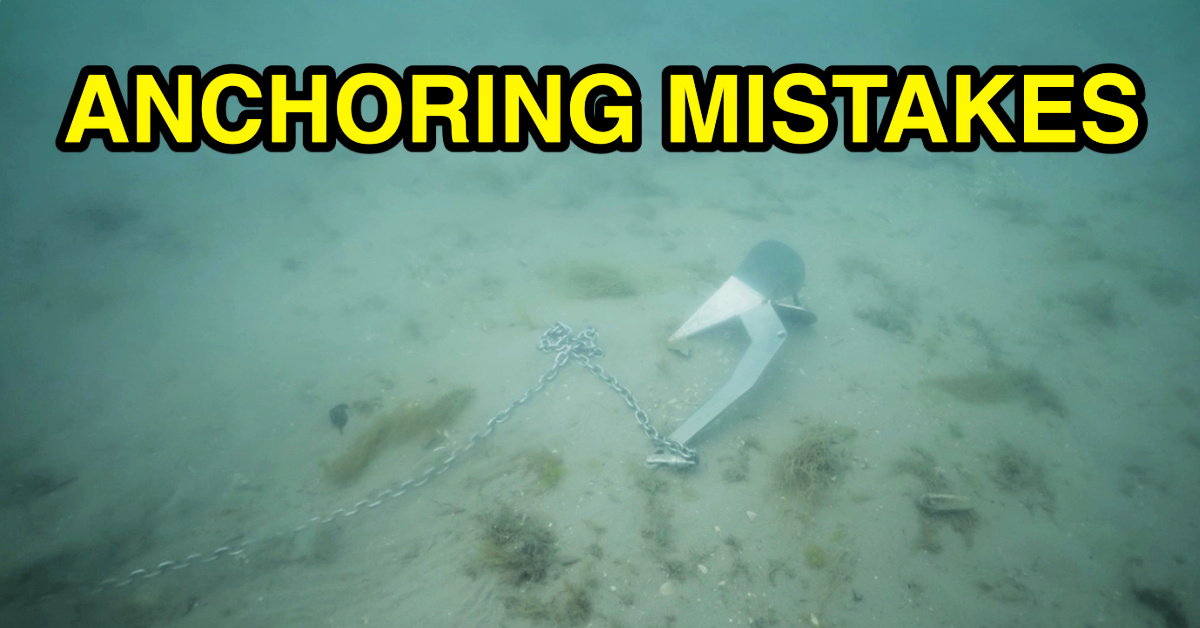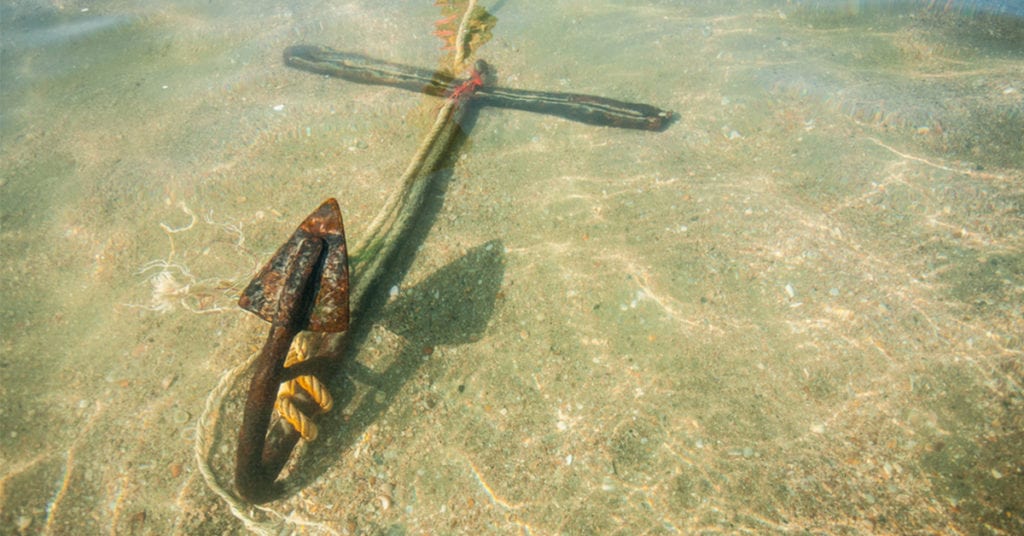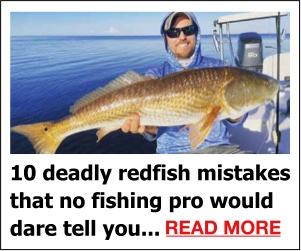Top 3 Biggest Anchoring Mistakes Most Anglers Make
- By: Joseph Simonds
- on
- Found In: Boat Anchoring, Boating, Boating Tips, Fishing Tips, Weekly Newsletter: 7-18-21

Wouldn’t it be nice if you could throw your anchor and confidently know it’s going to hold every time, in every condition, on any kind of bottom?
In reality, you should never have an anchor slip.
But are you using the right anchor for your boat?
This new video with Capt. Peter Deeks reveals the top 3 anchoring mistakes that most anglers make and how to avoid them.
Check it out below!
Top 3 Anchoring Mistakes [VIDEO]

Anchor Mistake #1
You don’t have an anchor that’s big enough for your boat so it just drags the bottom.
Be sure to use an anchor that’s as big as you can comfortably use (don’t go with the minimum size).
This will allow you to let out less line and as a fisherman, you want to anchor up close to where you’re fishing.
If you let out 150 ft of line in shallow water so your anchor holds, you’re going to drift WAY off your spot.
And with a heavier anchor, you can use less chain and that’s less noise and ease of use.
That’s also fewer chances of spooking off fish!
Anchor Mistake #2
We tested many different anchors on many different types of bottom: sand, mud, hard sand, hard rock, compact sand in inlets, shelly gravel bottom, and more.
And the second biggest mistake is using a style of anchor that’s wrong for the types of bottom you are fishing.
Here are just some examples:
- Bruce anchor: digs in soft sand and can grab onto rocks
- Grapnel anchor: good for rocky situations and around structure
- Folding grapnel anchor: nice and compact for kayaks in the shallows
Anchor Mistake #3
Don’t invest in the “popular” anchor.
If everybody has the same anchor, you assume it’s a great anchor.
But that’s not always the case.
Pick an anchor that makes sense for your boat and the type of bottom you’re fishing.
GREAT NEWS! The full course is ready and live!
And I’m certain you’ll be shocked at what anchors work and what they’re doing under the water.
Check out “The Best Boat Anchors Of All Time (Ranked Strongest To Worst…)” to see where your anchor ranks!
Scope For Anchoring
Your rode is the length of line from the end of your anchor (including your chain) to the end of your rope.
So, how long is your rode?
And how long “should” it be for anglers?
Here’s an example:
If the water is 10ft deep, the scope is how much rode you should let out.
In boating, this is typically a 1:7 ratio meaning that in 10 ft of water you’re going to let out 70 ft of line.
That’s crazy!
You should NOT have to do that to get your anchor to hold.
And this makes it really tough to position yourself correctly for fishing.
If you have the right anchor, you can make a 1:3 ratio work effectively to anchor your boat in any condition when you’re fishing.
Conclusion

If you want to catch more fish because you’re better positioned, better prepared, and save some money on the right anchor (versus investing in anchors that you don’t really need), then you’ve got to have the right anchor for YOU!
Check out “The Best Boat Anchors Of All Time (Ranked Strongest To Worst…)” to see where your anchor ranks!
Do you have any questions about these anchors?
Are there any anchors that we missed?
Let me know down in the comments!
And if you know someone who may be using the wrong anchor for their boat, please TAG or SHARE this with them!
P.S. Want access to our best fishing spots and tips, plus discounts to our online tackle store? Click here to join us in the Insider Club!
Related articles:
Related categories:
STOP WASTING TIME ON THE WATER!
Do what the “SMART ANGLERS” are doing and join the Insider Club.
Here’s what you’ll receive today when you join:
- Weekly fishing reports and TRENDS revealing exactly where you should fish every trip
- Weekly “spot dissection” videos that walk you through all the best spots in your area
- Exclusive fishing tips from the PROS you can’t find anywhere else
- Everything you need to start catching fish more consistently (regardless if you fish out of a boat, kayak, or land).










Interested to hear how you store your Bruce or plow anchors on your boat? My bay reef 196 has an anchor locker up front but really only made for fluke design. Any insight would be appreciated
Some boats have anchor lockers designed specifically for one type of anchor so it’s not possible to store any other type in the front anchor locker. The KW Bay Reef boats that I’ve seen have the anchor lockers for fluke anchors, so I’m not sure how you’d be able to store a plow anchor up there without having to do some reconstruction.
I was disappointed in this video. The title was misleading as it didn’t really point out the “Top 3” anchoring mistakes. Rather, it was essentially a 13 minute infomercial for the course with lots of teasers but little solid information.
I use my power pole or trolling motor spot lock most of the time on my skiff. I have a small Navy anchor on the boat. After watching this I bought a 6lb Bruce with 5 feet of chain. I know it will work when I need it.
This is a great session/ course that would have been great 20 years ago or more you don’t get cold what kind of anchor is good for your boat or how to rig it up the proper way.
Mantus M1 is the best anchor I have found in 40 years of sailing single hand & living aboard at anchor in various parts of southwest Florida mostly.
7 to 1 is the standard minimum with 10 to 1 the standard minimum for storm anchoring. I can verify these numbers as accurate because of many, very many of hundreds of anchoring events including hurricanes.
Short or shorter scope anchoring can be fine for temporary events but never forget the way one releases an anchor’s hold is to pull up on it which is what short scope does.
For an anchor to maximize its hold the pull needs to be as parallel as possible to the bottom.
That is the comprise or conundrum of short term short scope anchoring.
Though I don’t do short scope anchoring the extraordinary capacity of the Mantus M1 will dominate in this scenario as well is my prediction … Once it is set well by backing down on it.
Wind, current. Two biggies with anchoring. Also boat side height in windy conditions
Try upgrading your simple Grapnel Anchor for use on the sand with a SandWedJ Anchor Assist… Looking for market opportunities see this as http://www.sandwedj.com.au
Careful… The is no such thing as an anchor that will never drag. Six years on a 44ft cutter in the NW Caribbean and the standard bar conversation was about anchor dragging. In fact the aircraft carrier USS Eisenhower (CVN-69) pulled into Nassau for Christmas one year while we were there and anchored off Paradise Island. The second day they were there the Shore Patrol was sent into town to round up the crew and get them back aboard ship. It seems she had been dragging anchor most of the night. And it had not been an unusual weather night, just the normal easterlies but maybe a little more tidal current.
When I put a lot of road out I keep my boat closer to where I want by having the motor down and turning it right or left.
I can’t wait to watch this. I’ve checked my fluke anchor while scalloping and was surprised to watch it just slid along the grass doing nothing. I bought another one that folds simile to the fluke, but it’s got beefy “arms” and it seems to hold much better in the grass, probably due to the weight.